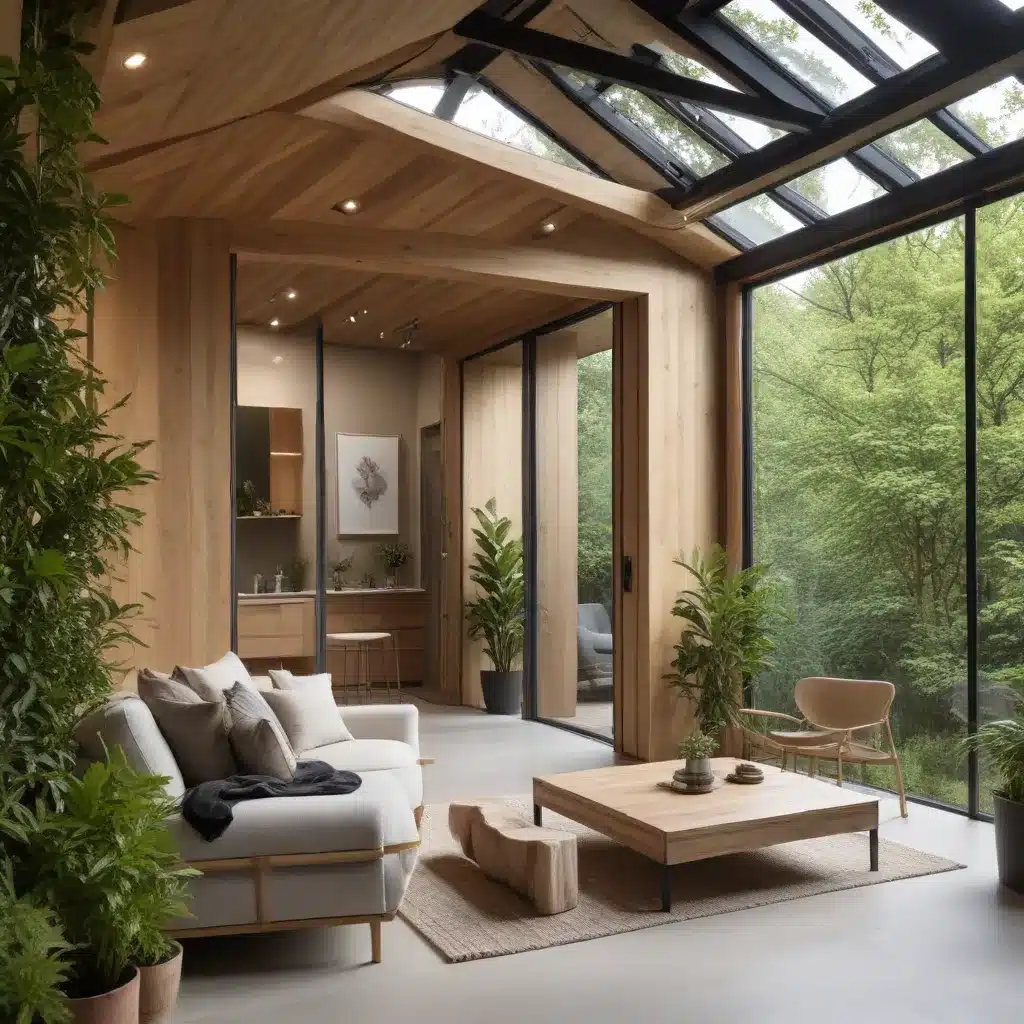
Understanding Biophilic Design
Biophilic design is a revolutionary approach to interior design that seamlessly integrates natural elements into our living spaces, creating a harmonious connection between our homes and the environment. This innovative concept stems from our innate affinity for nature, known as biophilia, and aims to enhance our physical, mental, and emotional well-being by reconnecting us with the natural world.
The Principles of Biophilic Design
At the core of biophilic design are six guiding principles that shape the creation of nature-inspired spaces:
- Visual Connection with Nature: Incorporating natural views, patterns, and forms to foster a direct visual link with the outdoors.
- Non-Visual Connection with Nature: Engaging the senses of sound, smell, and touch to evoke natural experiences.
- Non-Rhythmic Sensory Stimuli: Introducing variable, unpredictable natural elements that capture our attention and interest.
- Thermal & Airflow Variability: Replicating the natural fluctuations in temperature, humidity, and airflow found in the natural world.
- Presence of Water: Incorporating the soothing sights and sounds of water to create a calming, restorative atmosphere.
- Dynamic & Diffuse Light: Mimicking the changing intensity and distribution of natural light to enhance mood and productivity.
Incorporating Nature into Compact Homes
While biophilic design principles can be applied to any living space, they become particularly transformative in compact homes. By thoughtfully integrating natural elements, even the smallest of spaces can be elevated into sanctuaries that promote well-being and connection to the outdoors.
Benefits of Biophilic Design
The benefits of incorporating biophilic design into your home are numerous and far-reaching. These nature-inspired spaces can:
- Reduce Stress: The calming presence of natural materials, textures, and sounds can help alleviate anxiety and promote relaxation.
- Improve Air Quality: Strategic placement of plants and natural ventilation systems can enhance indoor air quality and regulate temperature and humidity.
- Boost Mood and Productivity: Exposure to natural light, greenery, and organic forms can uplift your mood and enhance cognitive function.
- Increase Connectivity: Blending the indoors and outdoors can foster a deeper connection to your local environment and the natural world.
- Enhance Property Value: Biophilic design features like living walls, water features, and natural materials can increase the aesthetic appeal and desirability of your home.
Bringing the Outdoors In
Natural Elements and Materials
The foundation of biophilic design lies in the seamless integration of natural materials and textures. Incorporate wood, stone, bamboo, and other organic surfaces to create a warm, grounding aesthetic. Opt for natural fabrics like linen, wool, and jute to add layers of tactile interest. When selecting colors, draw inspiration from the hues found in your local landscape, such as earthy neutrals, blues, and greens.
Spatial Arrangements and Layouts
Maximizing natural light and open layouts are crucial in biophilic design. Position your home to take advantage of available sunlight, and consider adding large windows, skylights, or glass walls to blur the line between indoor and outdoor spaces. Create intimate nooks and multi-functional zones that offer a sense of refuge while maintaining an overall feeling of prospect and openness.
Lighting and Ventilation
Harness the power of natural light to energize your spaces and regulate your circadian rhythms. Supplement with adjustable lighting systems that mimic the dynamic patterns of daylight. Prioritize natural ventilation through operable windows, ceiling fans, or strategically placed vents to enhance air quality and thermal comfort.
Biophilic Design Strategies
Vertical Gardens and Green Walls
Bring the outdoors in with the help of vertical gardens and living walls. These low-maintenance solutions allow you to incorporate lush greenery into even the most compact homes. Opt for drought-tolerant or native plant species to create authentic microclimates that connect your space to the local ecosystem.
Potted Plants and Living Walls
For those new to biophilic design, start with easy-to-care-for houseplants like snake plants, pothos, or succulents. Position them strategically on shelves, windowsills, or as focal points to instantly elevate the natural ambiance. If you have a bit more space, consider a living wall or self-watering planter system to create a striking botanical display.
Water Features and Aquariums
The calming presence of water can have a profound effect on your well-being. Incorporate a small indoor fountain, tabletop water feature, or wall-mounted waterfall to introduce the soothing sounds of moving water. For a more immersive experience, aquariums can serve as mesmerizing natural centerpieces, providing a window into the underwater world.
Adapting Biophilic Design for Compact Spaces
Space-Saving Furniture and Storage
In small homes, maximizing every square foot is crucial. Incorporate multi-purpose furniture, built-in storage, and space-saving solutions that seamlessly integrate natural materials and forms. Convertible desks, modular seating, and floating shelves can help you achieve a harmonious, nature-inspired aesthetic without sacrificing functionality.
Multifunctional Design Elements
Think beyond the obvious and explore multifunctional design elements that serve both practical and biophilic purposes. A window-mounted herb garden can provide fresh produce while also connecting you to the outdoors. Decorative screens or room dividers can double as living walls, offering a lush, natural backdrop.
Innovative Planting Solutions
When space is limited, get creative with your plant selections and placement. Opt for compact, trailing varieties that can be hung from the ceiling or mounted on walls. Consider self-watering planters and hydroponic systems to minimize maintenance and maximize your green footprint.
By embracing the principles of biophilic design, you can transform even the most compact of homes into peaceful, nature-inspired sanctuaries that nourish your mind, body, and soul. Whether you’re planning a whole-home remodel or seeking small updates, the possibilities for bringing the outdoors in are endless. For more inspiration and expert guidance, be sure to visit Reluctant Renovator – your one-stop resource for all things budget-friendly, eco-friendly, and family-friendly when it comes to home renovation.



